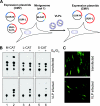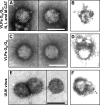Generation and analysis of infectious virus-like particles of uukuniemi virus (bunyaviridae): a useful system for studying bunyaviral packaging and budding
- PMID: 16928751
- PMCID: PMC1641803
- DOI: 10.1128/JVI.01362-06
Generation and analysis of infectious virus-like particles of uukuniemi virus (bunyaviridae): a useful system for studying bunyaviral packaging and budding
Abstract
In the present report we describe an infectious virus-like particle (VLP) system for the Uukuniemi (UUK) virus, a member of the Bunyaviridae family. It utilizes our recently developed reverse genetic system based on the RNA polymerase I minigenome system for UUK virus used to study replication, encapsidation, and transcription by monitoring reporter gene expression. Here, we have added the glycoprotein precursor expression plasmid together with the minigenome, nucleoprotein, and polymerase to generate VLPs, which incorporate the minigenome and are released into the supernatant. The particles are able to infect new cells, and reporter gene expression can be monitored if the trans-acting viral proteins (RNA polymerase and nucleoprotein) are also expressed in these cells. No minigenome transfer occurred in the absence of glycoproteins, demonstrating that the glycoproteins are absolutely required for the generation of infectious particles. Moreover, expression of glycoproteins alone was sufficient to produce and release VLPs. We show that the ribonucleoproteins (RNPs) are incorporated into VLPs but are not required for the generation of particles. Morphological analysis of the particles by electron microscopy revealed that VLPs, either with or without minigenomes, display a surface morphology indistinguishable from that of the authentic UUK virus and that they bud into Golgi vesicles in the same way as UUK virus does. This infectious VLP system will be very useful for studying the bunyaviral structural components required for budding and packaging of RNPs and receptor binding and may also be useful for the development of new vaccines for the human pathogens from this family.
Figures






References
-
- Barr, J. N., R. M. Elliott, E. F. Dunn, and G. W. Wertz. 2003. Segment-specific terminal sequences of Bunyamwera bunyavirus regulate genome replication. Virology 311:326-338. - PubMed
-
- Barr, J. N., J. W. Rodgers, and G. W. Wertz. 2006. Identification of the Bunyamwera bunyavirus transcription termination signal. J Gen. Virol. 87:189-198. - PubMed
-
- Betenbaugh, M., M. Yu, K. Kuehl, J. White, D. Pennock, K. Spik, and C. Schmaljohn. 1995. Nucleocapsid- and virus-like particles assemble in cells infected with recombinant baculoviruses or vaccinia viruses expressing the M and the S segments of Hantaan virus. Virus Res. 38:111-124. - PubMed
MeSH terms
LinkOut - more resources
Full Text Sources
Other Literature Sources

